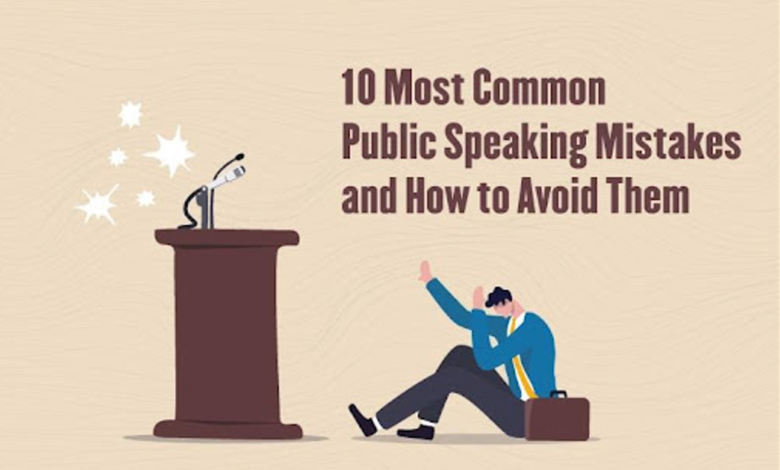
10 Most Common Public Speaking Mistakes and How to Avoid Them
If we ask you to rate yourself for your public speaking skills on a scale of 1-10, how many marks would you give? Well, if you are a budding speaker who has just started speaking in public and have not got a chance to deliver a talk at significant events yet, but still you rate yourself 9-10, it’s high time to do a reality check! Your self-assumption of “being perfect” often becomes the most significant mistake that gets in your way to successful public speaking and holds you back.
Sometimes, it happens that despite all possible efforts to crush your critical speaking engagements, they don’t go the way you want. But, it doesn’t mean that you should be disappointed with your failure. Instead, it simply implies that you need to run a retrospective to find the underlying cause of the loss and learn from your mistakes to succeed in future speaking gigs.
This article has unleashed some common mistakes that are unknowingly committed even by seasoned and experienced speakers. We have also provided valuable tips to avoid these errors. Read on and check if you are making any.
1 Not Tailoring Your Message to Your Audience
A one-size-fits-all approach is not applicable in the case of presentations. For instance, a small group of 10 people in an office meeting won’t respond the same way as 200 attendees listening to you in an auditorium or conference hall. In a nutshell, generic off-the-shelf speeches that are not poorly audience-centered sabotage your credibility as a speaker. These kinds of presentations make your audience annoyed and frustrated, giving them the impression that you don’t understand their needs and problems well and have not done your homework wholeheartedly. Eventually, they lose their attention which is difficult to retain. This mistake puts you on the back foot from which you may never rebound.
Tips to Avoid the Mistake:
Research about the psychographic, demographic, and behavioral characteristics of the audience. Also, get a thorough understanding of the problems and challenges. Then, based on the research data, create your message in different styles to develop an interest in different sub-groups and keep them intrigued throughout your slideshow.
2 Irritating and Annoying Mannerisms
Touching your face, scratching your head, adjusting your clothing or hair, clenching your hands, placing your arms behind your back, constantly moving around the stage, putting your hands in the pocket – all these acts make you more noticeable and divert the audience’s minds from what information you are delivering. Moreover, these gestures and small movements that you do subconsciously reflect your nervousness, anxiety, and impatience and dilute the impact of your message.
Tips to Avoid the Mistake:
Since these distracting mannerisms are a part of your personality, they won’t go overnight. You will have to do lots of practice to get rid of them. You can ask your family members and friends to record your speech when you practice. Oversee this recording and check your irritating mannerisms. Try to avoid them in your practice sessions. And keep practicing until you entirely do away with these habits.
3 Dumping Data in the Slides
Most of the speakers fill their slides to the brim with text for the sake of making their presentations information-rich, ignorant of the fact that this information load can do more harm than good. For example, if you put too much text in your slides, you end up reading the sentences instead of interacting with the audience. The audience will also tend to pay heed to what has been written on the slides instead of what you are saying. Further, it will also undermine your ability to persuade, connect, and inspire.
Tips to Avoid the Mistake:
- Avoid including long paragraphs; break your information into bullet points.
- Include the data that is most relevant to the topic.
- Don’t clutter the slides; leave white spaces for better clarity.
- Provide handouts to the audience for furnishing a longer explanation of any meaningful concept.
- Use visuals to get your message across.
4 Misusing Visual Aids
Beautifying your presentations with many images and infographics is detrimental to your slides and ruins the elegance and grace of the overall presentation. Meaningless and haphazard visuals confuse the audience and divert their attention from the core message. Misutilization of visual elements also negatively impacts your organization’s brand image and makes the target audience reluctant to believe in your ideas, products, and services.
Tips to Avoid the Mistake:
- Follow the “less is more” approach to make your presentations impactful.
- Use only high-resolution visuals that reinforce your message and make it more meaningful.
- For example, instead of relying on a single visual aid, use a variety of visual aids (such as charts, graphs, icons, or infographics for PowerPoint or any other presentation platform) to represent different data sets.
5 No Preparation
Presenting without preparation is one of the most common reasons for ineffective presentations. Preparation and practice make all the difference, and if you don’t prepare well in advance, you may look apprehensive, doubtful, and nervous. Without rehearsal, you end up using your slides as cue cards or reading from a script. This, in turn, diminishes your credibility as a speaker.
Tips to Avoid the Mistake:
- Know your target audience to whom you will be speaking.
- Choose a topic that is of interest to the audience.
- Decide on the beginning and end of the talk.
- Edit and proofread the content.
- Practice delivering the presentation before your colleagues, family members, or friends.
6 Attempting to Imitate Other Speakers
You often try to copy your favorite speakers and act like them to impress the audience, ignoring that public speaking is not about acting; it’s about the natural conversation. And in the attempt to mimic other speakers and incorporate their style in your speeches, you lose your authenticity and individuality. So the moment the audience realizes that you are masking yourself, they will lose their trust in you, and all your efforts to make connections with them will fall flat.
Tips to Avoid the Mistake:
- Use vocabulary and expressions that truly reflect you.
- Learn from other speakers and try to incorporate only those actions that best work for you.
- Don’t be afraid of revealing your genuine feelings and emotions when delivering your speech.
- Instead, infuse passion and personal touch in your presentations.
- Don’t adjust your opinions and thoughts to suit the requirements of others.
7 No ‘Hooks’ in the Slides
The first 30 seconds of your presentation are crucial to captivate the audience’s attention. If you don’t add a powerful “hook” in your first few sentences, the chances are high that you may lose the viewers’ interest in the rest of your slideshow. This “hook” may be a quote, fact, image, question, statistic, etc., that gives the audience a reason to listen to you till the last slide.
Tips to Avoid the Mistake:
- The hook must be relevant to the topic of your speech and keep it short.
- It must be interesting, engaging, and powerful enough to compel your audience to concentrate on what you have to say.
8 Forgetting to Make Eye Contact
Eye contact is vital during communication; however, most speakers underestimate its power and impact. For example, if you struggle to maintain eye contact with your audience during your speech, it gives an impression that you have not organized your thoughts, you are socially anxious. You have an introverted personality or don’t value the audience’s interest and response.
Tips to Avoid the Mistake:
- Practice maintaining appropriate eye contact.
- Make eye contact before you utter your first word.
- Don’t stare; hold your gaze for 4-5 seconds at a time.
9 Inappropriate Voice Modulation & Tonality
Not mastering the skill of varying the voice tonality and modulation is one of the most common mistakes most speakers make. The audience won’t comprehend your message if you speak too fast. And if you talk too slow, the audience will get frustrated. Remember, strained voice and fumbled words quickly tune out the audience, adversely impacting the communication.
Tips to Avoid the Mistake:
- Don’t speak too loud or too slow.
- Speak clearly; avoid mumbling.
- Take pause wisely to facilitate comprehension.
- Stress on certain words that are most important.
10 Exceeding the Allotted Time
If you think it’s wonderful to go over a few minutes to finish your presentation, you are wrong. Running overtime indicates disrespect towards the audience and the event organizers. The audience starts feeling uneasy if you don’t wrap up in your time limit, and they either stop listening to you or leave the session before you complete it.
Tips to Avoid the Mistake:
Arrive early to set up the required equipment in advance and start your presentation on time.
Make necessary editing to make your content crisp and concise.
Set time for each section of your presentation.
Invite the audience to continue the conversation with you during the break.
Rehearse to manage your time efficiently.
The Bottom Line
Remember, mistakes have the power to transform you into something better than you were before. So, instead of faking perfections, dare to admit your mistakes. Instead, work on your flaws sincerely to reach the zenith of success as a public speaker.

















